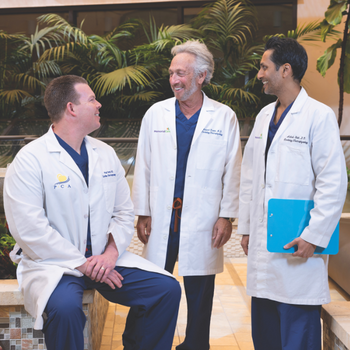For most people, their heartbeat is a steady, reliable rhythm. But for those with atrial fibrillation (AFib), the most common type of arrythmia, symptoms such as skipped heartbeats, fast pounding rhythms, shortness of breath or weakness may be persistent or may come in waves. In some cases, there are no symptoms at all. No matter the severity of symptoms, AFib can significantly increase the risk of stroke and other heart-related complications, so it must be controlled.
The first line of treatment is medication. If an alternative treatment is necessary, doctors at MemorialCare Saddleback Medical Center offer an array of minimally invasive procedures for adults.
Paul Drury, M.D., associate medical director of electrophysiology at MemorialCare Saddleback Medical Center, performs minimally invasive ablation therapies for AFib and other heart rhythm disorders. Using catheters – thin, flexible tubes threaded through blood vessels – he can access the inside of the heart and ablate pre-selected heart tissue. The ablation creates tiny scars, blocking the faulty electrical signals that cause arrhythmia.
Until recently, ablation required radiofrequency (hot) or cryoablation (cold) energy, plus fluoroscopy, which uses a stream of X-rays to create real-time video, allowing doctors to view their work inside the heart.
I perform a new technique called fluoroless ablation, which uses ultrasound and a GPS-like system instead of radiation to help guide the catheters. It’s the only ablation that doesn’t expose the patient to radiation, and MemorialCare Saddleback Medical Center is the only hospital in Orange County that offers it.
Ashish Shah, D.O., board-certified cardiac electrophysiologist and cardiologist with MemorialCare Saddleback Medical Center
Another treatment offered for AFib is convergent therapy, a relatively new procedure that requires a multidisciplinary team. During this minimally invasive procedure, a cardiothoracic surgeon inserts a catheter into the abdomen, and an electrophysiologist creates scars on the inside and outside of the heart. These lesions divert the irregular heartbeats and help the heart return to a normal rhythm.
“Cardiothoracic surgeons working with electrophysiologists is the wave of the future,” said Jeffrey Altshuler, M.D., medical director of cardiovascular surgery at the MemorialCare Heart & Vascular Institute at Saddleback Medical Center. “Patients get the best treatment and outcome when they have a multidisciplinary team evaluating their problems, and the minimally invasive procedures allow them to go home and recover faster.”
A vast spectrum of care
MemorialCare Saddleback Medical Center offers other catheter-based treatments for AFib and conditions related to it. For instance, the WATCHMAN™ device helps reduce stroke risk for those with non-valvular AFib. Whatever the procedure, the team at MemorialCare Saddleback Medical Center works together to ensure AFib patients have an excellent experience.
“Electrophysiologists stand shoulder-to-shoulder with one another, as well as with structural heart and cardiovascular surgeons,” said Howard Frumin, M.D., medical director of electrophysiology at MemorialCare Saddleback Medical Center. “We work well together and the patient benefits.”
For information about the MemorialCare Heart & Vascular Institute at Saddleback Medical Center, visit memorialcare.org/SBHeart.